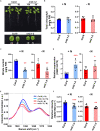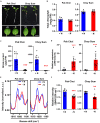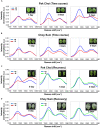Early Diagnosis and Management of Nitrogen Deficiency in Plants Utilizing Raman Spectroscopy
- PMID: 32582235
- PMCID: PMC7291773
- DOI: 10.3389/fpls.2020.00663
Early Diagnosis and Management of Nitrogen Deficiency in Plants Utilizing Raman Spectroscopy
Abstract
Nutrient deficiency alters growth and development of crop plants and compromises yield. Real-time non-invasive monitoring of the nutritional status of crops would allow timely applications of fertilizers to optimize for growth and yield at different times of the plant's life cycle. Here, we used Raman spectroscopy to characterize Arabidopsis and two varieties of leafy vegetable crops under nitrogen sufficient and deficient conditions. We showed that the 1046 cm-1 Raman peak serves as a specific signature of nitrogen status in planta, which can be used for early diagnosis of nitrogen deficiency in plants before onset of any visible symptoms. Our research can be applied toward crop management for sustainable and precision agriculture.
Keywords: Arabidopsis; Raman spectroscopy; leafy vegetables; nitrate peak; nitrogen deficiency.
Copyright © 2020 Huang, Singh, Park, Chua, Ram and Park.
Figures







Similar articles
-
Enhancing crop yield with the use of N-based fertilizers co-applied with plant hormones or growth regulators.J Sci Food Agric. 2015 Jul;95(9):1777-85. doi: 10.1002/jsfa.6938. Epub 2014 Nov 17. J Sci Food Agric. 2015. PMID: 25267003 Review.
-
Raman Spectroscopy Enables Non-invasive and Confirmatory Diagnostics of Salinity Stresses, Nitrogen, Phosphorus, and Potassium Deficiencies in Rice.Front Plant Sci. 2020 Oct 22;11:573321. doi: 10.3389/fpls.2020.573321. eCollection 2020. Front Plant Sci. 2020. PMID: 33193509 Free PMC article.
-
Raman Method in Identification of Species and Varieties, Assessment of Plant Maturity and Crop Quality-A Review.Molecules. 2022 Jul 12;27(14):4454. doi: 10.3390/molecules27144454. Molecules. 2022. PMID: 35889327 Free PMC article. Review.
-
Selection of Optimal Diagnostic Positions for Early Nutrient Deficiency in Cucumber Leaves Based on Spatial Distribution of Raman Spectra.Plants (Basel). 2025 Apr 12;14(8):1199. doi: 10.3390/plants14081199. Plants (Basel). 2025. PMID: 40284087 Free PMC article.
-
[Nitrate accumulation in vegetables and its residual in vegetable fields].Huan Jing Ke Xue. 2002 May;23(3):79-83. Huan Jing Ke Xue. 2002. PMID: 12145942 Chinese.
Cited by
-
Rapid Detection and Quantification of Plant Innate Immunity Response Using Raman Spectroscopy.Front Plant Sci. 2021 Oct 21;12:746586. doi: 10.3389/fpls.2021.746586. eCollection 2021. Front Plant Sci. 2021. PMID: 34745179 Free PMC article.
-
Time-resolved Raman spectroscopy using a CMOS SPAD array to remove fluorescent and fibre Raman backgrounds.Biomed Opt Express. 2025 Jun 17;16(7):2824-2834. doi: 10.1364/BOE.560826. eCollection 2025 Jul 1. Biomed Opt Express. 2025. PMID: 40677818 Free PMC article.
-
Non-Invasive Identification of Nutrient Components in Grain.Molecules. 2021 May 24;26(11):3124. doi: 10.3390/molecules26113124. Molecules. 2021. PMID: 34073711 Free PMC article.
-
Spectroscopic Analyses Highlight Plant Biostimulant Effects of Baker's Yeast Vinasse and Selenium on Cabbage through Foliar Fertilization.Plants (Basel). 2023 Aug 21;12(16):3016. doi: 10.3390/plants12163016. Plants (Basel). 2023. PMID: 37631226 Free PMC article.
-
Rapid metabolite response in leaf blade and petiole as a marker for shade avoidance syndrome.Plant Methods. 2020 Oct 27;16:144. doi: 10.1186/s13007-020-00688-0. eCollection 2020. Plant Methods. 2020. PMID: 33117429 Free PMC article.
References
-
- Blackmer T. M., Schepers J. S., Varvel G. E., Walter-Shea E. A. (1996). Nitrogen deficiency detection using reflected shortwave radiation from irrigated corn canopies. Agron. J. 88 1–5. 10.2134/agronj1996.00021962008800010001x - DOI
-
- Carter G. A. (1994). Ratios of leaf reflectances in narrow wavebands as indicators of plant stress. Int. J. Remote Sens. 15 697–703. 10.1080/01431169408954109 - DOI
-
- Cataldo D. A., Maroon M., Schrader L. E., Youngs V. L. (1975). Rapid colorimetric determination of nitrate in plant tissue by nitration of salicylic acid. Commun. Soil Sci. Plant Anal. 6 71–80. 10.1080/00103627509366547 - DOI
LinkOut - more resources
Full Text Sources
Other Literature Sources

